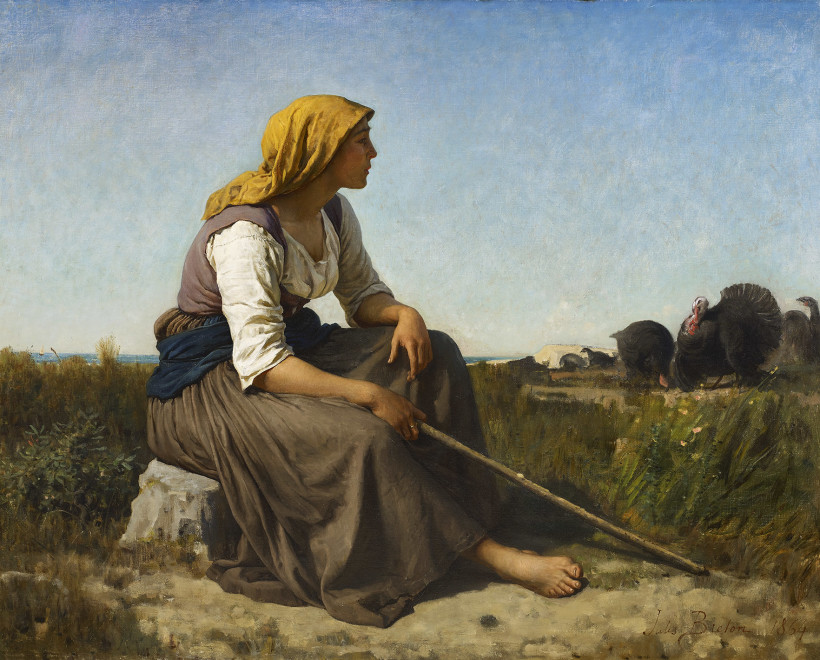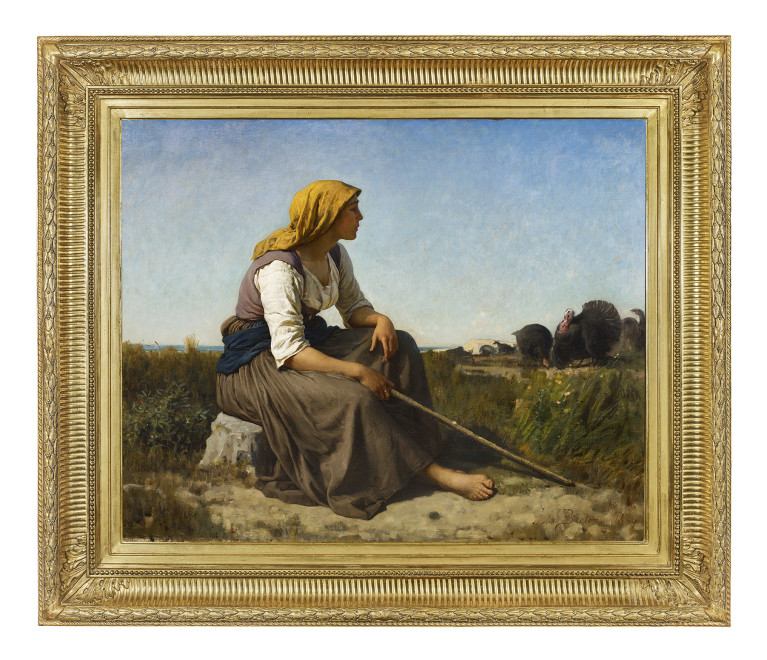The Turkey Tender is perhaps the greatest example of Breton’s desire to unite realism and historicism within a single image.
Provenance
M. Cahusac (probably sale, Drouot, Paris, 1887)Private Collection, New York (and sold, Sotheby’s: New York, October 24, 1996, lot 25, illustrated)
Private Collection, Minneapolis (acquired at the above sale)
Exhibited
Paris, Salon de 1864, No. 257Paris, Exposition Universelle, 1867, No. 87
Williamstown, Massachusetts, The Sterling and Francine Clark Art Institute, July 2014 – August 2018
Literature
Jules Breton, Un Peintre Paysan: Souvenirs et Impressions, Paris, 1896, p. 123Marius Vachon, Jules Breton, Paris, 1899, pp. 107-108, illustrated opp. p. 108
Hollister Sturges, Jules Breton and the French Rural Tradition, Omaha, 1982, pp. 132-133
Annette Bourrut Lacouture, Jules Breton: Painter of Peasant Life, New Haven and London, 2002, pp. 120-122, illustrated p. 175
Catalogue note
Jules Breton was born in Courrières, a village in the agriculturally rich region of northern France, and his intimate relationship to the land and the peasantry engendered in him a certain sympathy and tenderness that would characterize the interpretations of rural customs that dominated his oeuvre. Although his favored themes—gleaners, harvesters, and communicants—were popular subjects for realistic artworks and illustrations of genre types in nineteenth-century France, in Breton’s images, they are treated in an academic style traditionally reserved for classical figures.
The Turkey Tender is perhaps the greatest example of Breton’s desire to unite realism and historicism within a single image, casting a rustic figure into an established classical mold. Indeed, early critical responses to the work highlighted its classicist tendencies, including “a nobility of gesture, an elegance of contour, a majesty of line.”[i] And there was the sense, according to Pierre Gauthiez, that the image was invested with the values of the past, even as it portrayed a contemporary rural woman: “The sturdy peasant, the noble Gallic maiden who figures on his canvas, is an idealized type of our race, as he beholds her in the past with the eyes of enthusiasm, in the present by the light of faith, in the future by his belief in progress and beauty.”[ii]
Against the blue tonal sky of late afternoon and the faintest indication of the Mediterranean Sea, a statuesque young woman sits atop a rock. Her pose is relaxed, as her arms rest against her thighs and her stick held between two fingers has slipped to the ground. The very weight of her body, evident under folds of clothing, is a contrast to her fine features seen in profile and outlined in a version of the brownish pink of her headscarf. The expression is pensive, or even melancholy, recalling images of symbolic figures representing those sentiments. The low vantage point positions the viewer to look up at her against the horizon line.
Breton observed the scene represented in the painting on his passage through Languedoc and Provence in 1862, when he was traveling between the Duchâtel estate at Lagrange, where he had been commissioned to paint The Vintage at Château Lagrange (Joslyn Museum of Art, Omaha), and his home in Courrières. This journey coincided with a period during which Breton had become enamored of classical and Renaissance sources. A sketchbook dating from 1862 to 1864 includes a number of classically inspired figures and compositions, and adjacent sketches of a nude woman in loose drapery and a peasant girl in her work clothes, each wearing a headscarf, seated on a rock, and holding a walking stick provide insight into the conception of The Turkey Tender (figures 1 and 2). These drawings suggest Breton’s recognition of classical ideals in contemporary reality. As Theophile Thoré wrote, “Ideal in a turkey keeper! It is possible! Why does Breton elevate to grand art the simplest rustic compositions? It is because he is inspired in the middle of the countryside, he lives in the village of Courrières, he frequently uses its people as models, he loves them, and he knows how to reveal the human qualities of a vulgar existence.”[iii]
When The Turkey Tender debuted at the Salon of 1864, several critics also made note of its poetic quality. These commentaries may have been prompted by a drawing of a turkey keeper reproduced in L’Autographe (figure 3) and accompanied by a verse penned by the artist:
She was sitting motionless on a rock, looking fixedly at the sky. Nearby, some turkeys were pecking at the grass; in the distance, beyond some tamarisk bushes, the Mediterranean drew a straight blue line. I passed by this strange young woman and she did not deign to notice me. I looked at her for a while, but as it was extremely hot that day I came back to the village along the olive grove.[iv]
These lines, later described by Breton as a “an expression of memory,” perfectly evoke the moment that captured his attention, and which he then committed to canvas.[v] In his later years, Breton distinguished himself as a writer with a collection of poetry entitled Les Champs et la Mer (1875), followed by the long pastoral poem Jeanne (1880). In assessing Breton’s long career, one biographer suggested that the artist’s two occupations had necessarily influenced one another: “in his pictures we see how the poet’s mind has guided the painter’s hand.”[vi] This is certainly true of The Turkey Tender.
[i] Ernest Chesneau, Les Nations rivales dans l’art (Paris: Didier, 1868), 306.
[ii] Pierre Gauthiez, “Jules Breton: Painter and Poet,” Art and Letters, vol. 2 (April 1889): 120.
[iii] Theophile Thoré, “Salon de 1864,” Salons de W. Bürger 1861-1868 (Paris: Librairie Internationale, 1870), 91-92.
[iv] Jules Breton, “La Gardeuse de Dindons,” L’Autographe (May 1864).
[v] Jules Breton, Un Peintre Paysan: Souvenirs et Impressions (Paris: Alphonse Lemerre, 1896), 123.
[vi] Gauthiez, 116.




